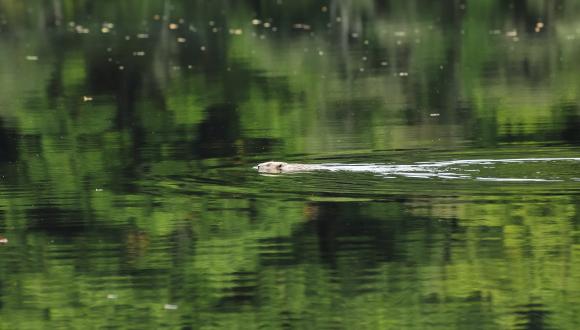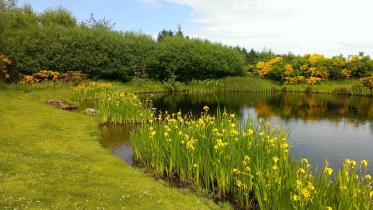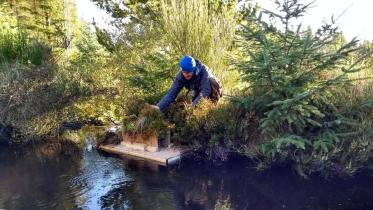Summary of beaver populations and licence returns covering the period 1st January to 31st December 2021
Key findings
- In 2020/21 a survey of the Forth and Tay catchments found 251 active beaver territories (as a minimum figure) which was estimated to equate to roughly 954 individuals (range 602 to 1381); a 30% annual increase in territories from 2017/18. This trend was expected to continue and a further year of recruitment occurred in 2021 (following the survey) further increasing the population.
- Licence returns for 2021 show that a total of 120 beavers were removed from conflict sites. Eighty seven beavers were killed under licence and 33 animals were trapped and translocated to licenced projects.
- Of those removed, the proportion that were trapped and translocated increased to 28% in 2021 compared with 21% in 2020 and in 15% in 2019.
- Translocation took place to a licenced project in Scotland, only the second to do so; following the Knapdale Reinforcement.
- Forty seven dams were removed under licence, as compared with 56 in 2020.
- The 2021 level of licenced removal equates to c. 10% of the expected population size and took place at 21 sites focused on beaver territories on Prime Agricultural Land.
- Given the population increases predicted from the 202/21 survey of the Tay and Forth catchments (30% p.a.) and that control took place on fewer properties than in either of the previous two years, we are confident that these removals will not have impacted negatively on Favourable Conservation Status.
Following the Scottish Government Policy announcement in November 2021 we aim to see further beaver releases in Scotland in 2022, including to new catchments. We also expect to see a further increase in the proportion of beavers that is trapped on conflict sites and a reduction in the proportion that is lethally controlled going forward.
Background
A detailed report was produced on beaver management in the first two years of EPS licensing.
- 2019 - NatureScot Beaver Licensing summary - 1st May to 31st December 2019
- 2020 - Beaver Management Report for 2020
In 2019 and 2020 we assessed the impact of licensed removals on the conservation status of the species and concluded that it continues to improve.
This summary focuses on beaver license returns for the calendar year 2021.
Population Monitoring
In 2020/21 a survey of the Forth and Tay catchments found 251 active beaver territories as a minimum figure which was estimated to equate to roughly 954 individuals (range 602 to 1381); a 30% annual increase in territories from 2017/18. This trend was expected to continue and a further year of recruitment took place over the course of 2021 (following the survey).
Changes to beaver licensing in 2021
All of the original two year licences issued in May 2019 expired during the Kit Dependency Period in 2021 (1st April to 17th August). NatureScot used this period as an opportunity to review our approach to beaver licensing; this included looking at compliance with licence conditions and reviewing individual licences based on new information; in some cases supplemented by site visits. Licence conditions were reviewed and new Codes of Practice were introduced to clearly set out the expectations around the use of lethal control and dam removal. Maps were also produced to accompany each new licence to provide clarity on the location and extent covered by a licence. A key change following this review has been that licences no longer include the Kit Dependency Period and licence holders that require to take action during this time, now need to apply for an exceptional licence.
Beaver Licenses were again reviewed following the outcome of a Judicial Review . The Court ruling upheld NatureScot’s approach to beaver licensing, but found that we had erred in law in that licences should have been issued with statements of reason. The ruling reduced all licences which were in place at the time of the hearing. Most licences in place at the time of the Judicial Review had since expired (c.40). Following consideration of the ruling all but one beaver licences were revoked (the remaining licence to cover possession and trapping). Licence holders were able to apply for a new licence if management control was still required. Based on any new information supplied and our knowledge of the history of impacts on sites, and where the licensing tests were met, new licences were issued along with a ‘Statement of reasons’. The Statement of Reasons sets out how the three licensing tests have been applied in each case. All new licences issued now include a Statement of Reasons.
Consequently 2021 saw a number of changes to beaver licences.
Returns summary
Our current licensing system generates a new licence number every time a new license is issued, amended or re-issued, hence some properties may have had three or more licences over the year, which covered the same area of ground. In this summary (Tables 1 and 2) we refer to the number of different properties on which a licence has been issued rather than the number of licences. This approach makes the data consistent with that published in previous years.
|
Activity licenced |
Purpose for which licence was granted - Preventing serious damage to livestock, foodstuffs for livestock, crops, vegetables, fruit, growing timber, property or fisheries - Prime agricultural land (PAL) |
Purpose for which licence was granted - Preventing serious damage to livestock, foodstuffs for livestock, crops, vegetables, fruit, growing timber, property or fisheries - Non-PAL |
Purpose for which licence was granted - Public Safety |
|---|---|---|---|
|
Lethal control and dam removal |
39 |
1 |
0 |
|
Dam removal only |
11 |
4
|
6 |
|
Trapping locations (noting covered by 1 licence) |
10 |
1 |
0 |
- Total licences current at some point in the year = 61
- Number of new licences in 2021 = 5 (2 permit lethal control)
The majority of licences were issued for the purpose of preventing serious agricultural damage, principally on Prime Agricultural Land (PAL). Licences on Non-PAL and for Public safety generally only permit dam removal (with 1 exception where the land is equivalent to PAL). Hence lethal control continues to be principally focused on PAL land.
Trapping was carried out on 11 sites, nine of which had licences that permitted the use of lethal control and beaver removal was authorised by NatureScot at a further two sites. All trapping was carried out under a single licence held by an experienced beaver ecologist.
|
Returns received |
59 |
|---|---|
|
Number of licences used (lethal control or dam removal). |
21 |
|
Lethal control – number of animals killed |
87 |
|
Number of animals trapped and removed |
33 |
|
Total number of animals removed |
120 |
|
Number of animals translocated to licenced projects (within Scotland) |
31 (5) |
|
Number of dams removed or modified |
47 |
|
Other |
1 burrow destroyed. |
Two licence holders did not submit returns despite several reminders. One licence was subsequently revoked and will not be renewed until a return is made with and the other licence holder did not have a current licence. Only 21 of the 61 (34%) of licences reported having taken any action in 2021 as compared with 67% in 2020. This possibly reflects that licences were in place for a slightly reduced period (from end of October to the date of renewal); that actions had been carried out in previous years and were not required in 2021 and that some licences were issued to cover specific interventions (often mitigation) that had been completed in 2020.
Lethal control was carried out under 13 licences, resulting in 87 animals being killed. The variation in the number of beavers killed under each licences likely reflects the variation in the size of the properties and thereby number of active beaver territories (and intensity of impacts) and that trapping was also being carried out in some locations (n=3). This compares with lethal control taking place under 19 licences in 2020.
Dam removal was reported on 14 returns with a total of 47 dams having been removed or modified.
Thirty three beavers were trapped, two of which died in holding due to pre-existing injuries. A family of five animals were released at a licenced release site in Scotland and 26 were moved to licensed release projects in England and Wales as follows:
- Broadridge Farm Devon - 1
- Derbyshire Wildlife Trust - 2
- Dorset Wildlife Trust - 1
- Foxfield Farm Cumbria - 1
- Hamathey Estate Cornwall -1
- Honicote Beaver Project, National Trust - 2
- Norfolk Rivers Trust - 2
- Nottingham Wildlife Trust - 6
- Seal Sanctuary Cornwall - 4
- Valewood, National Trust - 3
- Welsh Wildlife Trust - 3
Hence in total 120 beavers were removed from conflict sites in 2021. This level of licenced removal equates to c. 10% of the expected population size. Removals took place from a total of 21 sites, with a focus on beaver territories on Prime Agricultural Land (2 beavers were removed from non-PAL, but affecting PAL land). Of those removed, the proportion that were trapped and translocated in 2021 was 28%, compared with 21% in 2020 and in 15% in 2019.
Frequently Asked Questions (FAQs)
How have the changes in Government policy announced in November 2021 impacted on licence returns?
The policy for considering beaver releases in new areas of Scotland will not come into effect until summer 2022. Hence the beaver licensing figures for 2021 do not reflect the recent policy change.
We believe the proportion of cases where lethal control is necessary is already decreasing for a number of reasons. More land managers are now willing to engage with trapping as they see it can be effective and we are continuing to explore new mitigation methods to reduce conflicts and the thereby the need for beavers to be removed. NatureScot would expect to see a further change in the proportion of beavers that are trapped in conflict sites as opposed to lethally controlled. However, we anticipate that there will still be circumstances that requires the use of lethal control. The fact that beaver numbers are increasing may also continue to affect the absolute numbers that require to be removed.
Ahead of the new policy coming into effect, there remain opportunities for beaver releases within and on the edge of the existing range and NatureScot is exploring with the other public agencies where there may be opportunities for beaver releases on public land. However, all translocation projects will require a process of local engagement to assess their suitability. There also continues to be demand for beavers from conflict areas in Scotland for licenced release projects in England. Hence trapping is currently being promoted wherever feasible, with lethal control being a last resort.
What effect has the Judicial Review had on beaver licensing?
NatureScot revoked all beaver licences following the Judicial Review ruling at the end of October 2021 with further licences issued over a period of months depending on if/when they were requested by applicants. All beaver licences now include a Statement of Reasons which is specific to each licence and sets out the consideration with regard to the three licensing tests; that there must be a licensable purpose, that there is no satisfactory alternative and that the action must not be a detrimental to maintaining the species at favourable conservation status.
What is the impact of beaver management (lethal control and trapping) in 2021 on FCS?
A detailed assessment of beaver removal was carried out in 2020 in conjunction with the survey of the Forth and Tay catchments which allowed the impact of removal on territory occupancy to be assessed. We have not yet carried out a detailed analysis of the 2021 returns in the same way. However, from the figures (t=120 removed in 2021 compared with t=146 in 2020) and the location of removals (t=21 locations in 2021 compared with t= 32 in 2020) is evident that fewer removals have taken place from a smaller number of properties than in 2020; again principally relating to Prime Agricultural Land. This level of licenced removal equates to c. 10% of the expected population size, but is concentrated within a relatively small part of the beaver range.
In 2020 we concluded the number of beaver territories had increased and the conservation status of beavers in their natural range was improving and that whilst removals at current levels would be expected to impact at a local level (as is the intention), there was no discernible impact on the number of territories at a medium (stream section) or sub-catchment scale. NatureScot are continuing to work with the University of Newcastle on modelling beaver management scenarios to ensure that issuing licences does not have a negative (cumulative) impact on population growth.
Why can’t NatureScot require trapping instead of licensing lethal control?
Since beavers acquired European Protected Species status NatureScot has been working with land managers to explore the use of trapping as an alternative to lethal control. It has not been a legal requirement to require that trapping was used first. There remain circumstances where lethal control may be required either because trapping is unlikely to be effective for practical reasons or where lethal control may be required urgently to prevent serious damage. Our experience is that land managers are increasingly willing to explore the use of trapping as it has been found to be effective in reducing impacts. NatureScot intends to engage again with licence holders to explore what more could be done to make trapping workable in their circumstances and to support the delivery of this work. However, we do not consider it to be appropriate to revoke lethal control licences where they are still needed to prevent serious damage. Trapping can be authorised by NatureScot (following due consideration of the licensing tests) either by adding the location to the trapping licence or on sites where a licence that permits the use of lethal control has been issued.
What funding will be available for trapping for translocation projects?
NatureScot have produced interim guidance on the new translocation policy and have committed to providing financial assistance with the practical implementation of projects which includes the trapping, transportation, captive care and health screening of animals in addition to mitigation works at release sites. We anticipate working with experienced personnel to scale-up the trapping to meet the demand for beaver translocation projects that are approved in Scotland. We anticipate trapping will be staggered over time, partly due to the requirements for projects to be properly developed and approved and partly due to the temporal nature of trapping in conflict sites, and that this will allow the ‘supply and demand’ of beavers to be carefully managed. There are specialist skills and welfare considerations relating to the trapping and handling of beavers. We anticipate a small number of people being trained and co-ordinating this work.
What are the welfare implications of beaver translocation and lethal control?
In 2021 two beavers died in the process of translocation. In both cases the beavers had pre-existing injuries that contributed to their death. However, beaver welfare is a paramount consideration in carrying our beaver translocations and is only carried out by experienced personnel. NatureScot are working with the Scottish Animal Welfare Commission to review all aspects of beaver management.






